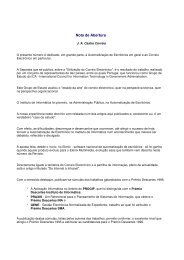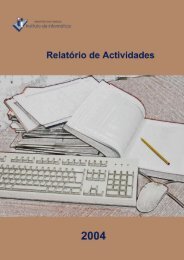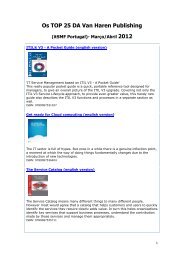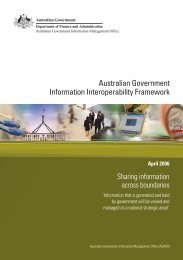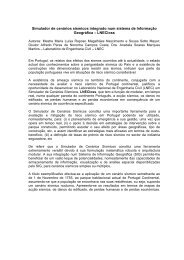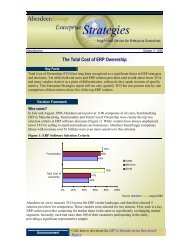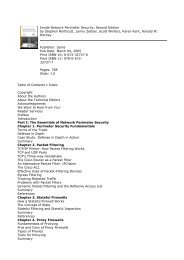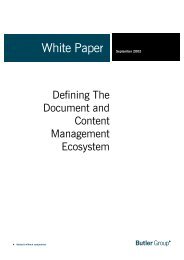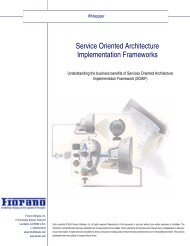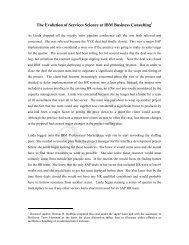OECD Peer Review of E-Government in Denmark - ePractice.eu
OECD Peer Review of E-Government in Denmark - ePractice.eu
OECD Peer Review of E-Government in Denmark - ePractice.eu
You also want an ePaper? Increase the reach of your titles
YUMPU automatically turns print PDFs into web optimized ePapers that Google loves.
Key po<strong>in</strong>t 7.3<br />
While Danish organisations clearly regard development <strong>of</strong> user-focused e-government as be<strong>in</strong>g important, this<br />
attitude appears to be driven more by the Danish government than by <strong>in</strong>dividual citizens and bus<strong>in</strong>esses. In<br />
practice, for most organisations this user-focus manifests <strong>in</strong> e-government strategies as a generic commitment,<br />
with fewer organisations appear<strong>in</strong>g to take more proactive steps towards this goal.<br />
Despite this, <strong>Denmark</strong> has made significant achievements <strong>in</strong> this area <strong>of</strong> e-government. In Europe, it is a leader <strong>in</strong><br />
terms <strong>of</strong> the sophistication <strong>of</strong> its onl<strong>in</strong>e services (especially those for bus<strong>in</strong>esses), and by their own assessment,<br />
significant percentages <strong>of</strong> the e-government services provided by Danish organisations are <strong>of</strong> an <strong>in</strong>teractive or<br />
transformational nature.<br />
Provid<strong>in</strong>g user-focused access to e-government<br />
In <strong>Denmark</strong> the <strong>Government</strong> has neither explicitly directed nor provided guidance to<br />
organisations over how e-government delivery should be undertaken (for example through<br />
implement<strong>in</strong>g some form <strong>of</strong> government-wide “channel management” or “multi-channel service<br />
delivery” strategy). The most common means <strong>of</strong> deliver<strong>in</strong>g e-government services is through<br />
organisation-level Web sites, which are used by 95% <strong>of</strong> all organisations that responded to the <strong>OECD</strong><br />
survey. Follow<strong>in</strong>g this, 61% <strong>of</strong> respondents reported us<strong>in</strong>g portals to deliver e-government, after<br />
which there was a significant drop to the use <strong>of</strong> voice services (i.e. call centres), and f<strong>in</strong>ally mobile<br />
phone-based channels (WAP and SMS).<br />
This strong tendency towards use <strong>of</strong> Internet-based delivery is consistent with the relatively high<br />
capacity <strong>of</strong> the Danish public to access and use e-government over the Internet, due to the high rates <strong>of</strong><br />
PC and Internet access (see Chapter 3). Clearly, Web sites and portals are the delivery channels that<br />
present the least challenge to Danish e-government <strong>in</strong> terms <strong>of</strong> achiev<strong>in</strong>g equity goals, and are also<br />
viewed as the delivery medium where there is the least constra<strong>in</strong>t on user demand.<br />
The significant difference between organisations’ delivery <strong>of</strong> e-government to users <strong>of</strong> home<br />
and/or bus<strong>in</strong>ess PCs (through Web sites and portals) versus users <strong>of</strong> mobile phones (via WAP and<br />
SMS) mirrors the situation <strong>in</strong> other <strong>OECD</strong> countries. With Danes be<strong>in</strong>g among the highest users <strong>of</strong><br />
mobile phones <strong>in</strong> the world, there is a significant opportunity for Danish e-government to become<br />
more user-focused by <strong>in</strong>creas<strong>in</strong>g the extent to which e-government services are delivered via mobile<br />
phones (so-called “m-government”). There is no data available on the channel preferences <strong>of</strong> Danish<br />
e-government users but it can be assumed that, across time, more Danes will be <strong>in</strong>terested <strong>in</strong> access<strong>in</strong>g<br />
government services via their mobile phones where this is a feasible and appropriate mode <strong>of</strong> delivery.<br />
Among the wide range <strong>of</strong> issues related to adapt<strong>in</strong>g services to mobile delivery that organisations will<br />
have to face, one particular government-wide concern will arise from the fact that the current<br />
approach to secur<strong>in</strong>g e-government through the use <strong>of</strong> PKI <strong>in</strong> <strong>Denmark</strong> is a PC-centric model that may<br />
not be compatible with mobile platforms (see Chapter 6).<br />
133



